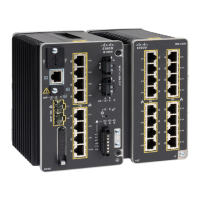B-8
Cisco IE 3000 Switch Software Configuration Guide
OL-13018-01
Appendix B Working with the Cisco IOS File System, Configuration Files, and Software Images
Working with Configuration Files
For flash:/file-url [dir/file...], specify the location on the local flash file system into which the tar file is
extracted. Use the dir/file... option to specify an optional list of files or directories within the tar file to
be extracted. If none are specified, all files and directories are extracted.
This example shows how to extract the contents of a tar file located on the TFTP server at 172.20.10.30.
This command extracts just the new-configs directory into the root directory on the local flash file
system. The remaining files in the saved.tar file are ignored.
Switch# archive tar /xtract tftp://172.20.10.30/saved.tar flash:/new-configs
Displaying the Contents of a File
To display the contents of any readable file, including a file on a remote file system, use the more [/ascii
| /binary | /ebcdic] file-url privileged EXEC command:.
This example shows how to display the contents of a configuration file on a TFTP server:
Switch# more tftp://serverA/hampton/savedconfig
!
! Saved configuration on server
!
version 11.3
service timestamps log datetime localtime
service linenumber
service udp-small-servers
service pt-vty-logging
!
<output truncated>
Working with Configuration Files
This section describes how to create, load, and maintain configuration files.
Configuration files contain commands entered to customize the function of the Cisco IOS software. A
way to create a basic configuration file is to use the setup program or to enter the setup privileged EXEC
command. For more information, see
Chapter 4, “Assigning the Switch IP Address and Default
Gateway.”
You can copy (download) configuration files from a TFTP, FTP, or RCP server to the running
configuration or startup configuration of the switch. You might want to perform this for one of these
reasons:
• To restore a backed-up configuration file.
• To use the configuration file for another switch. For example, you might add another switch to your
network and want it to have a configuration similar to the original switch. By copying the file to the
new switch, you can change the relevant parts rather than recreating the whole file.
• To load the same configuration commands on all the switches in your network so that all the
switches have similar configurations.
Yo u c an c opy ( upload) configuration files from the switch to a file server by using TFTP, FTP, or RCP.
You might perform this task to back up a current configuration file to a server before changing its
contents so that you can later restore the original configuration file from the server.
